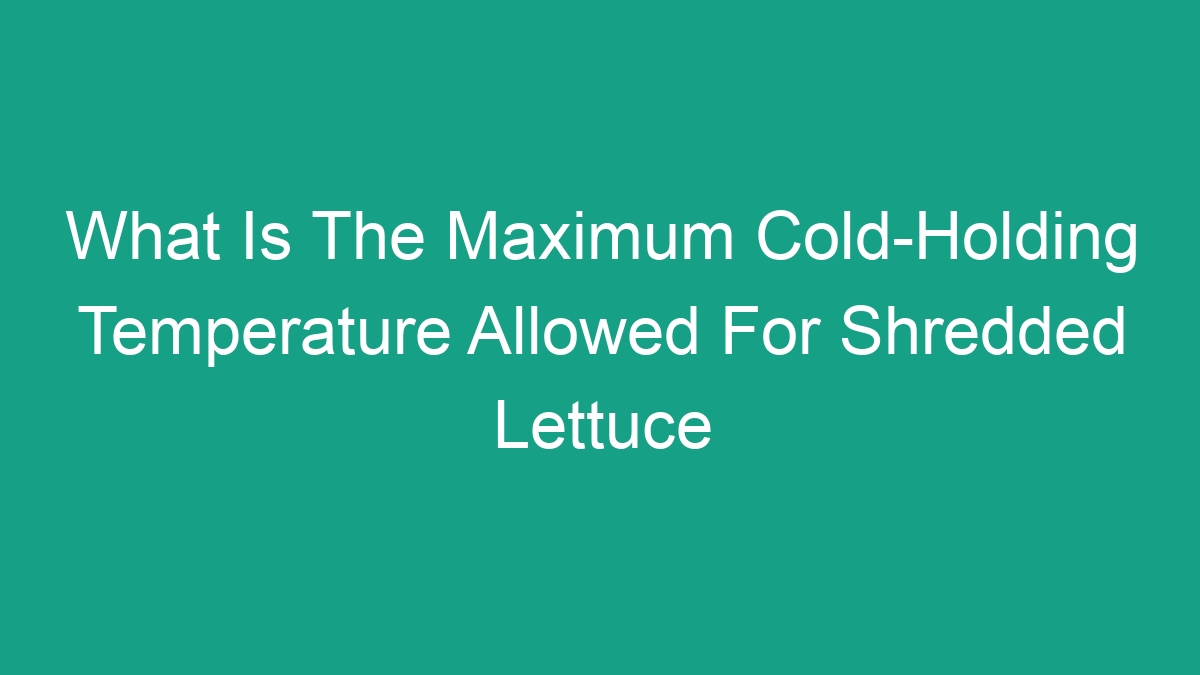
Introduction
Shredded lettuce is a popular ingredient in many dishes, from salads and sandwiches to tacos and wraps. However, ensuring that shredded lettuce is stored at the correct temperature is crucial to prevent the growth of harmful bacteria and to maintain its quality and freshness. In this article, we will discuss the maximum cold-holding temperature allowed for shredded lettuce and the importance of proper temperature control in food safety.
Importance of Proper Temperature Control
Proper temperature control is essential for preventing the growth of harmful bacteria in food, including shredded lettuce. Bacteria such as E. coli, Salmonella, and Listeria can proliferate in food that is stored at incorrect temperatures, leading to foodborne illnesses when consumed. In the case of shredded lettuce, which is often served raw, maintaining the correct cold-holding temperature is particularly important to ensure food safety.
In addition to preventing foodborne illness, proper temperature control also helps maintain the quality and freshness of shredded lettuce. When exposed to temperatures that are too high, lettuce can wilt, become soggy, and lose its crisp texture and vibrant color. This can negatively impact the overall eating experience and lead to customer dissatisfaction.
Regulatory Guidelines
In the United States, the Food and Drug Administration (FDA) sets regulatory guidelines for the safe handling and storage of food, including shredded lettuce. According to the FDA Food Code, which provides recommendations for food safety practices, the maximum cold-holding temperature allowed for shredded lettuce is 41°F (5°C). This temperature ensures that the lettuce remains chilled enough to inhibit bacterial growth while also maintaining its quality.
In food service establishments such as restaurants, delis, and cafeterias, adherence to these guidelines is not only important for public health and safety but is also a legal requirement. Failure to comply with temperature regulations can result in violations, fines, and even the closure of the establishment.
Best Practices for Cold-Holding Shredded Lettuce
In order to comply with regulatory guidelines and maintain the safety and quality of shredded lettuce, food service establishments should implement best practices for cold-holding. These practices include:
Refrigeration
Shredded lettuce should be stored in a commercial refrigerator or walk-in cooler that is capable of maintaining a temperature of 41°F (5°C) or below. It is important to regularly monitor the temperature of the refrigerator using a calibrated thermometer to ensure that it remains within the safe range.
Storage Containers
When storing shredded lettuce, it should be placed in shallow, covered containers to facilitate even chilling and to prevent cross-contamination with other foods. The use of food-grade plastic containers with tight-fitting lids is recommended to maintain the freshness of the lettuce and to prevent odors from permeating the product.
Ice Baths
In certain food service settings, such as salad bars or catering events, shredded lettuce may be displayed for self-service. In these instances, ice baths can be used to keep the lettuce chilled. The containers of shredded lettuce can be placed within larger containers filled with ice to maintain the proper temperature while on display.
Monitoring and Maintenance
In addition to implementing best practices for cold-holding shredded lettuce, it is crucial for food service establishments to regularly monitor and maintain the temperature of their refrigeration units.
Temperature monitoring should occur at least twice a day, and records of temperature readings should be kept as part of a food safety management system. If a refrigerator is found to be operating above the recommended temperature, corrective action should be taken immediately, such as adjusting the thermostat, repairing any malfunctions, or transferring the shredded lettuce to a different unit.
Additionally, regular maintenance of refrigeration equipment, including cleaning and servicing, is essential to ensure that the units continue to operate at the proper temperature and do not pose a risk to food safety.
Training and Education
Proper temperature control for shredded lettuce and other perishable foods is a responsibility that extends to all staff members in a food service establishment. Training and education on food safety practices, including cold-holding procedures, should be provided to all employees handling and serving food. This training should cover the importance of temperature control, the proper use of refrigeration equipment, and the procedures for monitoring and recording temperatures.
Moreover, ongoing communication and reinforcement of these practices is essential to ensure that all staff members understand and follow the established protocols for cold-holding shredded lettuce.
Conclusion
In conclusion, the maximum cold-holding temperature allowed for shredded lettuce is 41°F (5°C), as stipulated by regulatory guidelines set forth by the FDA. Proper temperature control is crucial for preventing the growth of harmful bacteria and maintaining the quality and freshness of shredded lettuce. By adhering to best practices for cold-holding, monitoring and maintaining refrigeration units, and providing thorough training and education to staff members, food service establishments can ensure the safety and satisfaction of their customers when serving shredded lettuce.



